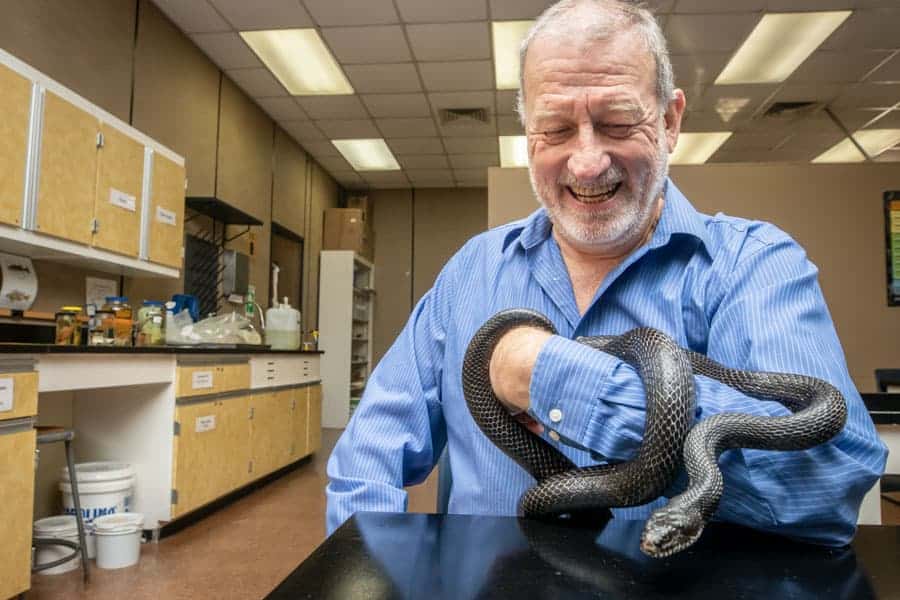March 13, 2019

New book by FMU Biology professor sheds much needed light on South Carolina reptiles
For young Jeff Camper, there was no better time growing up in (then) rural Aurora, Illinois than those summer days when the big mowers came by to cut the fields behind his house.
The big machines were exciting, the smell of the newly mown grass intoxicating, and, best of all from Camper’s eight-year-old point of view, the operation stirred up a writhing, slithering army of garter snakes.
“I would catch them by the dozen,” Camper says. “I learned pretty quick to leave the ones with the blue eyes alone because they were mean and would bite. I didn’t know until later that it was because they were molting and were irritated at being bothered. …It was just a great time.”
A great time for a boy like Camper, who thought that snakes, and every other critter in the reptile family, were just the coolest things around. Another fact that he didn’t pick up until later was that not everybody in the world shared his enthusiasm for reptilia squamata and all its kin.
Now, after decades of study, Camper — Dr. Jeff Camper, professor of biology at Francis Marion University — not only knows snakes like they were wrapped around the back of his hand. He knows that most people fear and dislike them.
He also knows that many are fascinated by them.
That’s one reason he’s excited about the impending publication of The Reptiles of South Carolina, a 288-page field guide to, as the name suggests, the state’s many reptiles (University of South Carolina press, 288 pages, 171 illustrations).
The book is a serious academic work — Camper has done yeoman’s work during the past decade or so synthesizing countless studies and scholarly articles in a comprehensive guide — but he believes it will also entertain and enlighten a popular audience. That’s an audience the Camper says has been underserved for … well, forever.
“What’s amazing to me is that there really hasn’t been a comprehensive field guide for the reptiles of South Carolina,” says Camper. “This is a state that has a significant reptile population. All our neighboring states have a guide like that but we don’t. That’s essentially how I came to work on this project. I thought it was something that was needed.”
Camper, a Midwesterner who wound up at FMU in 1994 after completing his doctoral work at Texas A&M University, says there’s been plenty of reptile study and research in South Carolina. The state is a perfect environment for these animals so reptiles are prolific and available for serious study.
“It is a really a great place for someone with an interest like mine,” says Camper.
But the research has been uneven across the state, and for decades, no one has put together a serious overview.
Most of Camper’s work in Reptiles of South Carolina is synthesis. It does offer a number of new conclusions regarding various aspects of reptiles here. In particular, Camper says the book offers much more detailed information on species range than is found in any previous guides.
“Typically, what you find is a range map and it’s basically just the whole state,” says Camper. “I think that’s done because they knew (a particular species) was over here and over there, and even though there was no real research in between, it was just assumed they were just everywhere.”
That’s not the case, says Camper. A number of well-known South Carolina snakes, for instance, appear to have tightly confined ranges. The pine snake he says, long shown to be extant statewide on the aforementioned range maps, is probably only found in small areas in both the Upstate and the Coastal Plain.
That will be of interest to experts in the field. Camper hopes laymen can become just generally more informed about the true nature of snakes and reptiles, and will find them more agreeable, or at least less disagreeable, once a few myths are dispelled.
“The biggest misunderstanding I hear about snakes is that they are dangerous,” says Camper. “The vast majority of snakes are not dangerous and snakes really aren’t aggressive towards humans — at least none of the ones around here. If more people understood snakes more fully, there’d be less fear I think.”
Perhaps a nice comprehensive book will help.